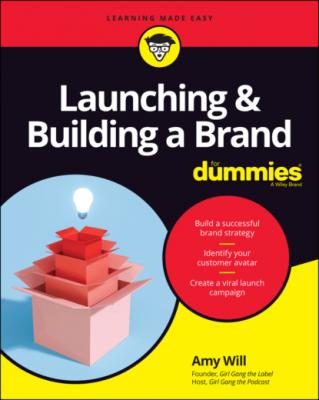Launching & Building a Brand For Dummies. Amy Will
Чтение книги онлайн.
Читать онлайн книгу Launching & Building a Brand For Dummies - Amy Will страница 11
 credibility and trust
credibility and trust
Establish themselves as thought leaders
With a personal brand, your efforts focus mostly on the following activities:
Discovering who you really are and finding your most attractive (and in-demand) traits, knowledge, and skills
Expressing, in a genuine way, who you are, what you do, and what makes you so special Fake it till you make it doesn’t work; people will eventually see past the façade.
Being your best you — you are your business and your product, so you need to embrace learning and self-improvement
Building a strong portfolio, which may involve earning credentials, developing or gathering samples of your work, or soliciting customer testimonials or reviews — anything that demonstrates success in your field
Attending or speaking at industry events and other opportunities to get your name and face in front of people
Presenting content that demonstrates your knowledge and expertise — articles, blog posts, social media posts, photos, videos, podcasts, white papers, and so on
Engaging with customers and prospects to answer questions and solve problems to further demonstrate your knowledge and expertise
Other brand types
The brand types I’ve covered to this point are all business and commercial. Other brand types include the following:
Public brand: One owned by the government, such as the Internal Revenue Service, National Oceanic and Atmospheric Administration, and Central Intelligence Agency
Nongovernmental organization brand: One owned by a not-for-profit organization that isn’t affiliated with any government group, such as the Cooperative for Assistance and Relief Anywhere, Ceres, and the American Heart Association (AHA)
Event brand: One created to attract participants, attendees, and sponsors, such as Burning Man, NASCAR, the Olympics, and the Cannes Film Festival
Grasping Brand Architecture Basics
If you’re planning to create several related brands, you need to choose the brand architecture that establishes how they’re related. You have two options:
Branded house (monolithic) consists of a master brand (usually, a company) with multiple subbrands (typically, divisions, product families, products, or services), all of which ride the coattails of the master brand. Virgin has several subbrands, including Virgin Records, Virgin Atlantic, Virgin Mobile, Virgin Comics, Virgin Wines, and Virgin Care.
House of brands (freestanding brands) consists of several stand-alone companies, product families, products, or services, each with its own brand identity, none of which refers to the corporate brand. Proctor & Gamble has a wide variety of consumer brands, including Bounty, Charmin, Gillette, Puffs, and Tide.
Most organizations and people use branded house architecture because it offers the following benefits:
Easier and more affordable: You build and manage a single brand.
Stronger: Everything you offer reinforces a single brand. Another way to look at it is that you don’t have a bunch of separate brands that dilute the master corporate brand.
Increased brand equity: A single brand generally has more equity built into it and is easier to sell. With multiple brands, a prospective buyer of the business may want some brands and not others, and will expect to pay less for the business as a result.
Here are a few situations in which the house-of-brands architecture may be the better choice:
You have deep pockets and a large corporation with diverse companies, divisions, or families of products or services.
You want to introduce a new product to the market that would dilute or clash with your existing brand’s identity. Suppose that an automobile manufacturer that built its brand around luxury vehicles decides to offer a line of economy vehicles. Selling economy vehicles would weaken the company’s reputation for designing and building luxury vehicles, so creating a stand-alone brand probably would be best.
You build or are planning to build a company by acquiring multiple stand-alone brands.
Knowing When to Brand
Do you really need to build a brand to accomplish your business, organization, or career goals? Well, not really, but building a brand will generally enable you to accomplish your goals faster and raise your level of achievement. In this section, I explain situations in which building a brand is always beneficial.
Opening a new business
Whenever you open a new business, you’re creating a brand, so before you even name your business, give some serious thought to how you’re going to create a brand around it. Especially pay attention to the following tasks:
Identify your niche — what your business plans to do different and better than existing businesses in the same space (see Chapter 2)
Define your brand identity — your business’s vision, mission, and values, and what makes it special (see Chapter 3)
Clarify your branding goals, and establish ways to measure your progress toward achieving those goals (see Chapter 4)